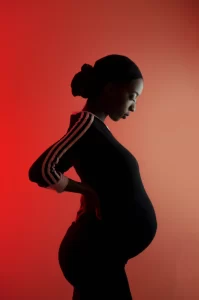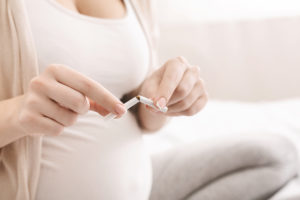By Iris Farrou
01 Sep, 2023
Lifestyle Tips, Menopause, New Moms, Peri-Menopause, Peri-Menopause, Postpartum, Prevention, Women's Health
abdominal, Childbirth, constipation, dysfunction, floor, obesity, Pain, painful sex, pelvic, Physical Therapy, pilates, Pregnancy, pregnant, PT, tailbone, weakened pelvic floor, Why is sex painful

When we hear about pelvic floor exercises, we often associate them with either older women, or pregnant women/women who have just given birth. This is a common misconception–older women and new mothers may see immediate benefits when engaging in pelvic floor PT, but everyone can benefit from it.
No matter your age or overall physical health, if you were assigned female at birth, knowledge is power when it comes to knowing what your pelvic floor looks like, and what it does:
- Imagine your pelvic floor as a hammock of support consisting of muscles, tendons, ligaments, nerves, and connective tissue. This hammock is between the tailbone and the pubic bone.
- First and foremost, your pelvic floor supports the bowels, bladder, uterus, and vagina; there are also muscular bands that pass through the pelvic floor that encircle the urethra, vagina and anus.
- All this, when it functions properly, plays a key role in bowel and bladder control. Your pelvic floor also helps you stabilize your pelvis and your spine, and assists with sexual function.
Who is at risk of Pelvic Floor Dysfunction?
Remember that the pelvic floor is mostly made up of muscles, and like any muscles in our body those–too–can weaken or suffer damage and lead to pelvic floor dysfunction. People who have experienced pregnancy, childbirth, chronic constipation, or obesity may be at higher risk as their pelvic floor has, and does, work harder to support their normal bodily functions and the bowels/bladder.
Some of the symptoms of pelvic floor dysfunction may include pain during intercourse, bladder pain, bowel or urinary incontinence, frequent urination, persisting pubic, tailbone, or lower abdominal pain, and constipation–to name a few. More serious issues may include pelvic organ prolapse: bowel prolapse, prolapsed uterus, and even endometriosis.
How can Physical Therapy Help?
Physical therapists are not just experts who help you walk better after an injury, they are medical experts in the functions of muscles, joints, and nerves, and have an in-depth and holistic understanding of human health. Just like any medical field, PTs have areas of expertise and you may want to work with someone who is trained on pelvic floor functions.
A PT will assess your whole body after consulting with you, not just the problem or painful areas. Your medical history, symptoms, and needs will of course be taken into account to create an individualized plan for your pelvic floor health. The exercises will, and should, be done with the physical therapist–unless they assign you specific exercises to do at home. Since our pelvic floor is basically holding everything in our body together, the center so to speak, don’t be surprised if some exercises are not directly working on the pelvic area; ask your PT to explain why they are assigning you an exercise, and how it will help you. Some soreness or aches are normal after your PT sessions, but this is not a “no pain, no gain” situation: at no point during PT should you feel acute pain or strain on your muscles/ligaments.
And for this subject, the saying “the sooner, the better” cannot be emphasized enough: do not wait until you’re older, pregnant, or have any painful symptoms to get started on strengthening your pelvic floor.
More
By Iris Farrou
15 Aug, 2023
Diet & Exercise, Health Conditions and Pregnancy, Heart health, Lifestyle Tips, New Moms, Parenting, Pregnancy, Prevention, Women's Health, Your baby's health
Can I use antiperspirant while pregnant, Dehydration prevention, Diet during hot summer, Dizziness, Effects of overheating on pregnancy, Exercise During Pregnancy, Fainting Prevention, high temperatures, Hot Flashes during Pregnancy, How to stay hydrated while pregnant, Overheated, Overheating while Pregnant, Pregnancy, pregnant, Protecting my baby in the heat, Regulate Body Temperature

In some parts of the country the weather is starting to cool down at this time of year, but there are still areas being affected by heatwaves. Even if you’re not in the Midwest, the South, or any other part of the US where heat persists well into September, keep in mind that bigger cities suffer higher temperatures regardless. When you’re pregnant, you have an increased amount of blood in your body, which can make you feel hotter all the time. If you combine that with the summer heat, things can get really uncomfortable…
It’s a good idea to always be aware of the risks that come with a summer pregnancy:
- You are more likely to become overheated, and suffer from dizziness, nausea, headaches, or even muscle cramps.
- With that being said, keep in mind that the chances of fainting, or losing your step and falling, are higher: this could result in a more serious injury and endanger your baby’s health–even bringing on early labor or placental abruption.
- Dehydration is one of the risks associated with overheating. If your temperature is consistently above 101 degrees, you should be seeing your doctor. High fever– especially in the first trimester–has been shown to impact fetal development, particularly the fetal heart structure and neural tube defects.
- If you work outdoors, if your job requires manual labor, if you are working in a building that’s not climate controlled, or if you work in a commercial kitchen, you should know you are at higher risk of overheating while pregnant.
Though being pregnant is not the same experience for everyone, and not all people have the same advantages, opportunities, and support from family and friends during their term, the following steps are recommended so as to keep you and your baby safe:
- Since you are liable to overheat when pregnant, try to stay out of the heat as much as possible–especially if the outside temperature is higher than 90 degrees.
- Know that if your body temperature is higher than 102 degrees for more than 10 minutes, that puts you at a higher risk for heatstroke.
- Swelling and pregnancy go hand in hand, and in the summer heat this may get worse. Try to elevate your feet as much as you can, and stretch often. If you can, avoid standing for long periods of time.
- Your body is working for two, so with a higher blood volume, you will be sweating more. That’s your body trying to keep you cool: drink lots of water to avoid dehydration, and try to wear clothes that allow heat to escape.
- Underarm antiperspirant is not your friend: you need to allow your body to regulate its temperature, so you don’t want to trap heat in you. Try to wear light, breathable fabrics that help you cool down, and always use sunscreen to protect your skin from overheating.
- If you are exercising, it is best to stay inside and use AC– it is the best thing you can do for your safety to be in climate controlled environments, drink as much water as possible, and cool down every chance you get.
- Avoid the sun, avoid high sodium foods, and avoid all other drinks but water: non-alcoholic cocktails or other drinks have sugar and other ingredients that are not helping your cause. Water should be your beverage of choice.
Always trust your instincts when it comes to how you are feeling, and always listen to your body: even if the environment is seemingly cool and safe, if you feel that something is not right, follow your gut and seek medical attention.
https://www.heart.org/en/news/2019/07/01/summer-heat-brings-special-health-risks-for-pregnant-women
https://www.cdc.gov/niosh/topics/repro/heat.html
https://www.unitypoint.org/news-and-articles/10-things-no-one-expects-during-a-summer-pregnancy
More
By Iris Farrou
26 May, 2023
Diet & Exercise, Lifestyle Tips, New Moms, Pregnancy, Prevention
Body While Pregnant, Healthy Body during Pregnancy, Healthy Skin During Pregnancy, How to Prevent Stretch Marks, Physical Changes During Pregnancy, Pregnancy, pregnant, Prevention, Skin Elasticity, Stop Stretch Marks, Stretch Marks, Vitamins for Pregnant Women

We often associate stretch marks with pregnancy, and for many women they are an extra cause for concern; our bodies change a lot during pregnancy, and new mothers are in a quest to re-discover themselves after giving birth. Visible changes on the body can be an aspect of pregnancy that many women want to prevent or treat, and stretch marks are on the front lines of self-esteem.
Though pregnancy and stretch marks may go together, these lines can appear on our skin due to weight fluctuations or bodybuilding as well–especially if our skin rapidly stretches or shrinks. They are most often seen on the stomach, thighs and hips, breasts and upper arms, as well as lower back and buttocks. Stretch marks are very common, especially among pregnant people to a 50-90%.
How do they happen?
We know that weight fluctuations can lead to stretch marks, and you may be familiar with their red or pink hues. Lots of people also experience irritation or itchiness where stretch marks are forming, and do notice they appear as sunken lines on the skin. If our skin rapidly stretches or shrinks, the elastin and collagen in it breaks. Elastin has the role of allowing our skin to stretch, and collagen’s role is to provide structure and support for our skin. As our skin heals after weight or muscle changes, stretch marks usually appear where elastin breaks.
Can they be prevented?
Especially during pregnancy, you want to ensure that your skin maintains its maximum elasticity in order to prevent stretch marks; you need to keep it supple and well hydrated.
- Enrich your “skin food” by supplementing elastin and collagen. Eat foods rich in Vitamins E, C, B2, B3, as well as rich in zinc and silica. Consume at least 2 liters of water a day to keep your skin strong and help it renew.
- Use topically applied products to help your skin’s elasticity. Bio-oil is a great first step from the first trimester to help your skin remain well-hydrated.
- You can also exercise, if your health allows it, to improve circulation that will keep your skin elastic and more able to stretch as it grows. Improved circulation will also help lessen the possibility of varicose veins and swollen ankles during pregnancy.
Other methods
During pregnancy you should be careful to use products that will not harm your baby, and focus on natural means of improving your skin’s elasticity. Beyond pregnancy, or if you are interested in diminishing stretch marks caused by other reasons, you can turn to some of the following treatment options: use of retinol creams, microneedling, dermabrasion, and laser skin resurfacing.
https://americanpregnancy.org/healthy-pregnancy/pregnancy-concerns/prevent-pregnancy-stretchmarks/
https://my.clevelandclinic.org/health/articles/10785-stretch-marks
More

The first thing that anyone will tell you is that smoking while pregnant is not good for the health of you or your baby. More specifically, it can cause an early delivery or a baby to be born too small. It can also cause certain birth defects, or even stillbirth. You should also remember that second-hand smoking or being exposed to tobacco smoke while pregnant can also cause serious issues. Though quitting before your pregnancy is ideal, early on during your term is the next best. Whatever the case may be, it is never too late during your pregnancy to quit smoking.
Studies show that about 10% of women smoke while pregnant, though this does not justify it. The percentage is higher among women who have been diagnosed with psychiatric problems. Since smoking is an addiction, it is likely that many women cease for the duration of their pregnancy but revert to it after their baby is born. With post-partum depression lurking, mothers who were smokers are more likely to go back to smoking even if they are still breastfeeding.
Birth Defects
Babies born to mothers who smoked during their pregnancy are more likely to have an orofacial cleft, which is a defect of the mouth and lip. A cleft lip can happen between the 4th and 7th week of pregnancy, if the tissue that forms the facial structures of the baby does not join completely at the lip, and possibly palate, before birth.
Babies who are exposed to other people’s tobacco are more likely to develop ear and lung infections, such as bronchitis and pneumonia. Second-hand smoking in this manner can also trigger asthma attacks, and it increases the risk of Sudden Infant Death Syndrome.
Nicotine Products
In their effort to quit smoking, many people will turn to e-cigarettes or other nicotine products. However, none of these options are safe to use during pregnancy as nicotine can damage a developing baby’s brain and lungs. On top of the danger nicotine poses, some of the flavorings used in e-cigarettes are also harmful to a developing baby.
Smoking and Breastfeeding
Though many women will pause smoking for the duration of their pregnancy, it is likely that they relapse after their baby is born. Nicotine and other chemicals are transferred into the breast milk at high levels, and you may be surprised to know that the amount of nicotine that accumulates in the breast milk and transfers to the baby is double that of the amount transferred through the placenta.
Women who smoke are more likely to have a lower milk supply, and to wean their babies faster than women who do not smoke during breastfeeding.
If you are considering a pregnancy, and are struggling with quitting smoking seek advice from your healthcare provider or doctor, and develop a quitting plan as early as possible to protect your health and the health of your baby.
More




